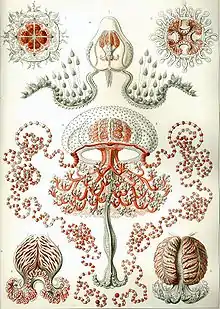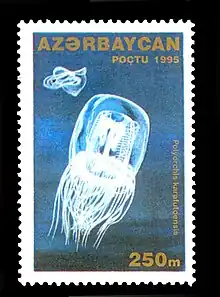Anthoathecata
Anthoathecata, or the athecate hydroids, are an order of hydrozoans belonging to the phylum Cnidaria. A profusion of alternate scientific names exists for this long-known, heavily discussed, and spectacular group. It has also been called Gymnoblastea and (with or without an emended ending -ae), Anthomedusa, Athecata, Hydromedusa, and Stylasterina. There are about 1,200 species worldwide.[1]
| Anthoathecata | |
|---|---|
 | |
| Anatomical details of Pandeidae (Filifera). Lower left, top right: Neoturris pileata. Lower right: Stomotoca pterophylla. From Kunstformen der Natur by Ernst Haeckel (1904) | |
| Scientific classification | |
| Domain: | Eukaryota |
| Kingdom: | Animalia |
| Phylum: | Cnidaria |
| Class: | Hydrozoa |
| Subclass: | Hydroidolina |
| Order: | Anthoathecata Haeckel, 1879 |
| Suborders | |
|
and see text | |
| Synonyms | |
| |
These hydrozoans always have a polyp stage. Their hydranths grow either solitary or in colonies. There is no firm perisarc around the polyp body. The medusae, or jellyfish, are solitary animals, with tentacles arising from the bell margin, lacking statocysts but possessing radial canals. Their gonads are on the manubrium ("handle").[2]
Except in Eudendriidae and Laingiidae, prey can be captured by discharging harpoon-like structures (desmonemes) from chambers (cnidae) in specialized cells (nematocysts) on the tentacles. In hydrozoans, these are nearly always adhesive and entrapping, rather than puncturing and poisoned as in other jellys.[2]
Systematics

Upper left: blue top snail (Calliostoma ligatum).
The close relationship of the orders Anthoathecata and Leptomedusae has been long known, but formerly it was also believed that these two were close to the order Limnomedusae. However, their closest relatives are the highly advanced Siphonophorae, whereas the Limnomedusae are a rather primitive group, and not very closely related to these three Leptolinae, and might instead belong to the subclass Trachylinae.
Some uncertainty existed regarding the taxonomy of the order Anthoathecata. The most simple scheme, used until recently by most authors since it was proposed in 1913, divided the order into a smaller suborder (Filifera) and a second larger one (Capitata), but several unusual Anthoathecatae did not fit into this arrangement, and a considerable number did so awkwardly. The Porpitidae, for example, are a highly aberrant group, and were at one time even considered a separate order "Chondrophora". However, they are currently considered to be derived from Zancleida. In the early 21st century, the well-known Hydra and its relatives – and most of the supposed filiferan infraorders Tubulariida and Moerisiida – were determined to be a very ancient lineage, recognized as suborder Aplanulata.[3] Although not all Anthoathecatae have been firmly placed in the phylogeny, most are fairly certainly assigned at least to one of the major subdivisions. As a notable exception, a prehistoric family, the Heterastridiidae, is still highly disputed regarding its relationships to the extant taxa, as are a small number of very aberrant and/or little-known species such as the aptly named Saccohydra problematica.
The family Clathrozoellidae is placed with the Filifera here; in others it is placed in the Leptomedusae and sometimes even synonymized with their family Clathrozoidae. By contrast, the supposed filiferan genus Anthohydra is in fact the leptomedusan Eugymnanthea; similarly, "Gammaria" is also a leptomedusan and properly spelled Grammaria.
The supposed athecate family Monobrachiidae is apparently a close relative of the Olindiasidae, and belongs in the Limnomedusae. Halammohydridae and Otohydridae, sometimes placed here, appear to be trachyline hydrozoans of the order Actinulidae.
Infraorders and families


|
Basal and incertae sedis Anthoathecata
Suborder Aplanulata Collins, Winkelman, Hadrys & Schierwater, 2005
Suborder Filifera Kühn, 1913 Basal or incertae sedis
Infraorder Margelina Haeckel, 1879 (disputed)
Infraorder Pandeida (disputed)
|
Suborder Capitata Kühn, 1913 Basal or incertae sedis
Infraorder Moerisiida Poche, 1914 (disputed)
Infraorder Sphaerocorynida Petersen, 1990 (disputed)
Infraorder N.N.[5] (disputed)
Infraorder Zancleida Russell, 1953 (disputed)
|
References
- Schuchert, P. (2014). Anthoathecata. Accessed through: Schuchert, P. (2014) World Hydrozoa database at http://www.marinespecies.org/hydrozoa/aphia.php?p=taxdetails&id=13551 on 2014-10-31
- Bouillon, J.; Gravili, C.; Pagès, F.; Gili, J.-M.; Boero, F. (2006). An introduction to Hydrozoa. Mémoires du Muséum national d'Histoire naturelle, 194. Muséum national d'Histoire naturelle: Paris, France. ISBN 2-85653-580-1. 591pp. + 1 cd-rom
- Collins, A. G., Winkelmann, S., Hadrys, H. and Schierwater, B. (2005), Phylogeny of Capitata and Corynidae (Cnidaria, Hydrozoa) in light of mitochondrial 16S rDNA data. Zoologica Scripta, 34: 91–99. doi:10.1111/j.1463-6409.2005.00172.x
- Schuchert (2014), World Hydrozoa database.
- New name is required for the remaining Tubulariida, because Tubulariidae has been moved to Aplanulata.
Bibliography
- Buecher, E., Goy, J. & Gibbons, M.J. 2005. Hydromedusae of the Agulhas Current. African Invertebrates 46: 27-69.